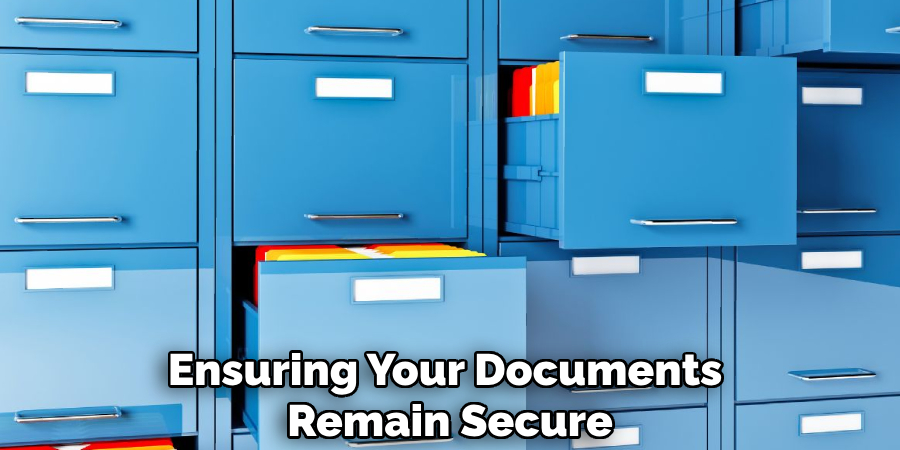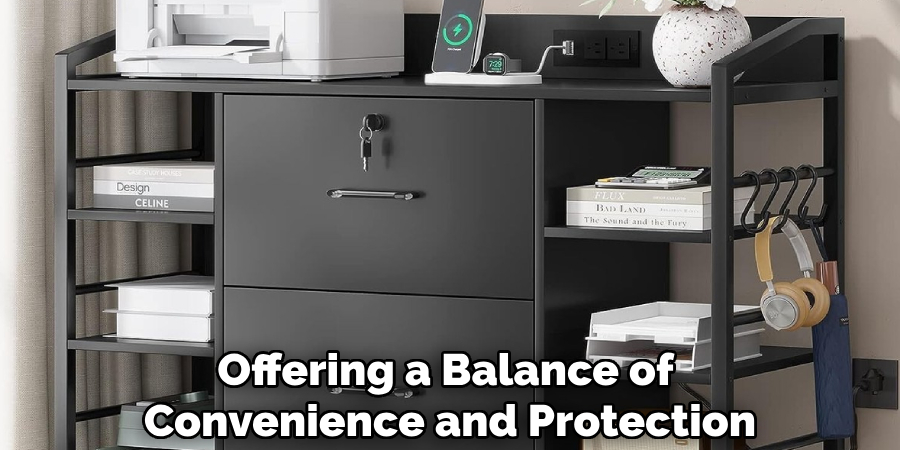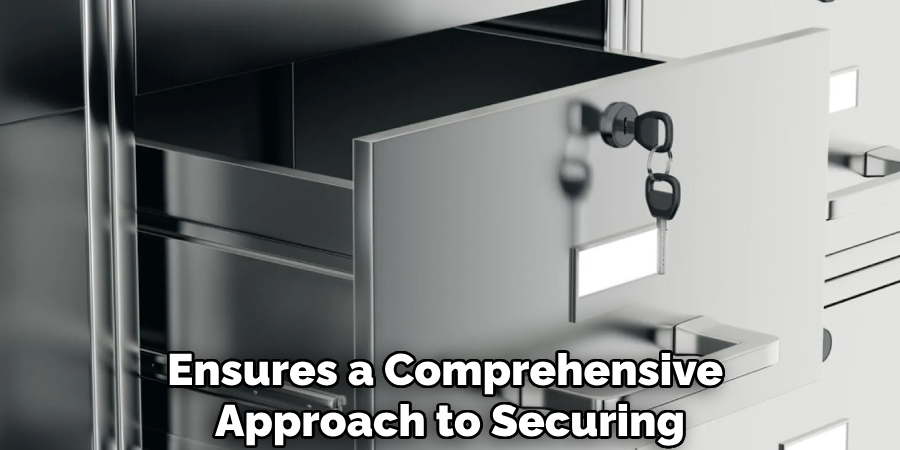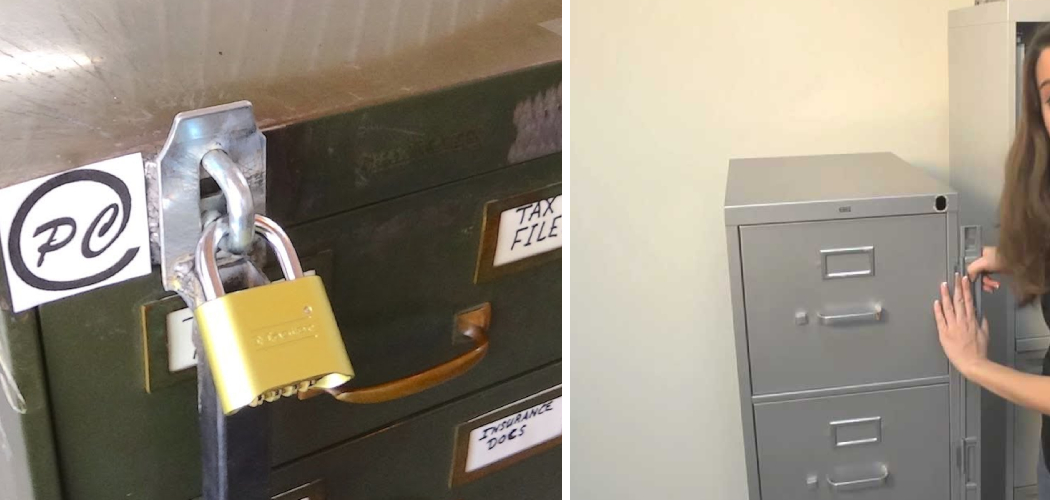Securing a file cabinet without a built-in lock can be challenging yet essential. Whether in an office or home environment, file cabinets often store sensitive documents that require protection from unauthorized access. Without an effective locking mechanism, these items are vulnerable to theft, tampering, or accidental loss. Understanding how to lock a file cabinet with nolock is crucial for safeguarding important information and ensuring organizational security.

This article overviews practical, DIY, and commercial methods to secure file cabinets without built-in locks. From simple solutions like lock bars and cable locks to creative DIY approaches, the goal is to help you find a method that matches your needs, budget, and preferences while maintaining the functionality of your cabinet.
Assessing Your Cabinet Type and Security Needs
Before choosing a method to secure your file cabinet, it’s important to assess your cabinet type and your specific security needs. Different cabinets require different solutions, and understanding their design is crucial to finding the most suitable option.
Determine Cabinet Style
The style of your file cabinet greatly influences the locking solution you choose. For instance, vertical cabinets, which are tall and have a smaller footprint, may require solutions that fit their narrow profile. On the other hand, lateral cabinets, which are wider and shorter, could benefit from locking mechanisms designed for their broader structure. Additionally, the cabinet’s material—metal, wood, or plastic—should be considered, as certain locks may adhere better to one material. The drawer design, such as single or double drawers, also affects the compatibility of locking mechanisms.

Security Needs Assessment
Evaluate your security requirements carefully. If the goal is to deter tampering, a heavier-duty or tamper-proof locking system is recommended. However, simpler options like cable locks might suffice if you simply need a light deterrent. Based on how you use your cabinet, consider whether portability or ease of lock removal is a priority.
Accessibility Considerations
Finally, think about how frequently you need access to your files. If frequent access is required, opt for a locking system that is quick and easy to unlock. A more robust or multi-step locking system might be acceptable for occasional use. Determining these factors ahead of time helps ensure you choose the most effective and convenient solution for your needs.
How to Lock a File Cabinet With Nolock: Using External Locking Bars
What Is a Locking Bar?
A locking bar is a metal bar that is mounted externally on the surface of a file cabinet to provide additional security. These bars are designed to block the drawers from being opened unless the padlock securing the bar is removed. Locking bars are ideal for safeguarding sensitive or confidential information stored in file cabinets.
Installation Steps
- Drill and Mount the Bar: Begin by positioning the locking bar alongside the edge of the cabinet where it can effectively prevent the drawers from opening. Mark the location of the screws and drill the necessary holes.
- Attach and Secure the Bar: Attach the bar using the provided screws and brackets. Once mounted, slide the bar into its locking position and secure it with a heavy-duty padlock to ensure maximum protection.
Pros and Cons
Pros:
- High-level security, as the bar prevents access to all the drawers simultaneously.
- Durable and reliable, offering a physical deterrent to theft or tampering.
Cons:
- Installation may require permanent modifications to the cabinet, such as drilling holes.
- Can be less convenient for frequent access, as the padlock must be removed each time.
Recommended Products
For quality and reliability, consider locking bars from reputable brands like ABUS and Master Lock. Both companies offer cabinet lock bars designed for durability and strength, ensuring your documents remain secure.

Installing Cabinet Drawer Hasps
Hasp locks are a simple yet effective solution for securing individual drawers or cabinets. They consist of a hinged metal plate that closes over a staple, which is then secured using a padlock. This basic design makes hasps an affordable, easy-to-install option for light-duty security needs.
Installation Guide
To install a hasp lock, start by selecting the desired location on the cabinet or drawer where the latch and staple will align correctly when closed. Use screws to attach the hinge plate to the cabinet body, ensuring it sits flush and operates smoothly. Then, fasten the staple to the drawer or moving part of the cabinet, ensuring it aligns securely with the latch plate. Always use screws appropriate for the material of the cabinet, such as wood or metal, to ensure a secure fit.
Choosing a Suitable Padlock
Pairing your hasp with the right padlock is crucial for security. Opt for a robust, weather-resistant padlock that fits snugly through the staple without excess space, minimizing tampering opportunities.
Ideal Use Cases
Hasp locks are best suited for single-drawer or low-value item storage where security needs are moderate.
Drawbacks
While functional, hasp locks may impact the appearance of your cabinet and are not recommended for high-security applications due to their limited strength.
Using Cable Locks for Temporary Security
Description of Cable Locks
Cable locks offer a versatile and temporary solution for securing drawers and preventing unauthorized access. These locks typically consist of a flexible cable that can be threaded through drawer handles and locked securely into place. Their adaptability and ease of use make them an excellent choice for renters or situations where permanent installation is not an option.
How to Use
- Start by looping the cable through all the drawer handles that need to be secured.
- Ensure the cable is tightly threaded to prevent any easy access to the contents.
- Secure the cable by locking it with a sturdy padlock or built-in locking mechanism.
Advantages
- No Drilling or Permanent Damage: Cable locks do not require any structural modifications, preserving the integrity of the furniture.
- Ideal for Renters or Temporary Security: Perfect for temporary setups or when permanent locking options are not feasible.
Best Practices
- Keep the lock mechanism out of view to avoid unwanted attention.
- Use coated cables to prevent scratches or damage to the surface of your furniture.
Cable locks are a reliable and non-intrusive way to enhance security, offering a balance of convenience and protection.

DIY Locking Methods
When professional locks aren’t an option, DIY locking methods can provide a degree of safety and security. Here are some effective solutions:
- Velcro Straps with Locks: Wrap-around Velcro straps combined with a small padlock create a simple and adjustable security solution. These are particularly useful for securing drawers or cabinet doors without causing damage.
- Sliding Bolt Locks: Install sliding bolt locks on the sides of cabinets or furniture. These locks can be paired with a padlock for added security. They’re sturdy and effective, but installation requires minor modifications to the furniture.
- Magnetic Child Locks: These are discreet, quick to install, and great for low-level security, such as keeping children from accessing specific sections. Magnetic locks are invisible from the outside, maintaining the furniture’s aesthetic.
Cautions
While these DIY methods offer convenience and adaptability, they are generally less secure than professionally installed locks. A determined individual may still bypass them with some effort. Consider the level of security you need and the potential risks before relying solely on these options.
Alternative Security Strategies
When traditional or DIY locking methods are insufficient, other strategies can effectively enhance cabinet security. These options can offer additional layers of protection, especially in environments where higher security or creative solutions are necessary.
Securing the Cabinet in a Locked Room
If securing individual drawers or cabinets proves challenging, consider locking the entire cabinet. This form of environmental control limits access at the room level, creating an additional barrier to unauthorized entry.
Anchor or Chain the Cabinet
Anchoring or chaining the cabinet to a wall or floor ensures that it cannot be easily moved or stolen as a whole. This method is beneficial for cabinets containing heavier items or valuables and can serve as a deterrent for would-be thieves.
Motion or Open Sensors
While not traditional locks, motion or open sensors can alert you if a cabinet is tampered with. These devices detect movement or the opening of drawers and can send notifications or sound alarms, making them an effective monitoring tool.
Labeling and Obfuscation
Sometimes, subtle strategies work best. Labeling the cabinet to make it appear unimportant or empty can reduce its attractiveness as a target. Combining this with other methods ensures a comprehensive approach to securing your belongings.

Conclusion
Securing a file cabinet with no lock can be effectively achieved through various methods such as lock bars, hasps, cable locks, or even creative DIY solutions. Each option offers unique advantages, and the best choice depends on your specific needs, budget, and whether permanent modifications to the cabinet are acceptable. It’s essential to test your chosen methods to ensure their reliability in protecting your valuables.
Additionally, consider integrating backup security strategies for greater peace of mind. Understanding “how to lock a file cabinet with nolock” empowers you to safeguard your belongings without compromising on practicality or efficiency.

